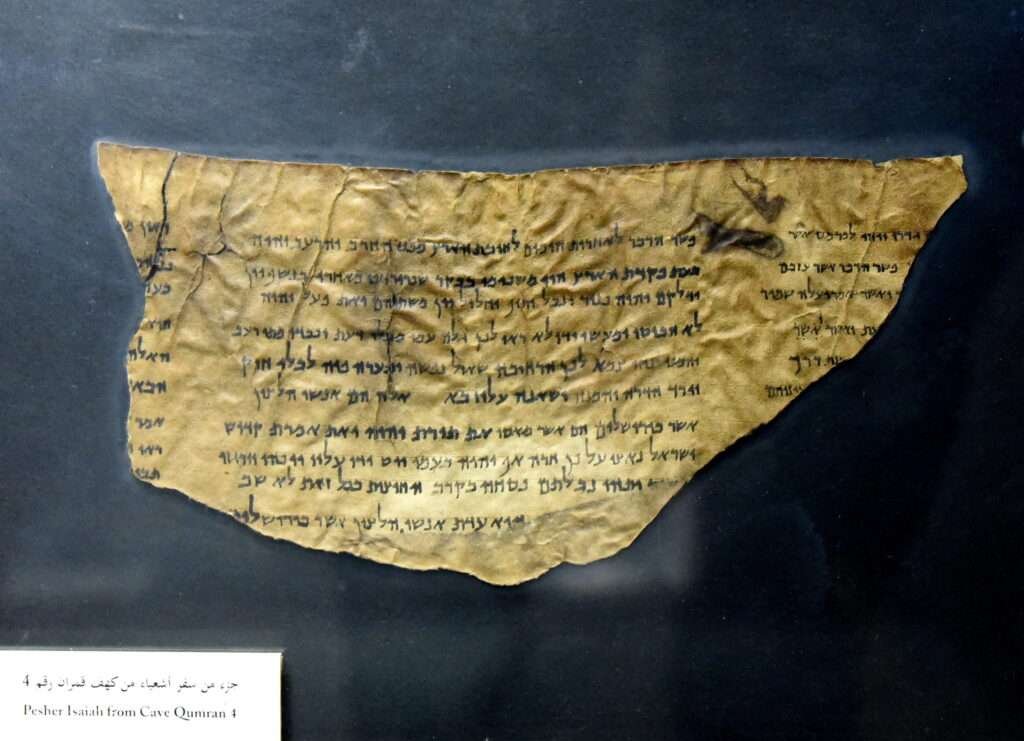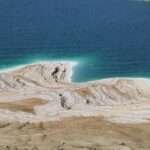The Dead Sea Scrolls are over 900 ancient Jewish manuscripts (represented by more than 25,000 fragments) discovered in 11 caves near Qumran between 1947 and 1956. Written mainly in Hebrew with Aramaic and Greek, they include the earliest copies of many Hebrew Bible books and unique sectarian texts, revolutionizing biblical and historical studies.
What Are the Dead Sea Scrolls?
The Dead Sea Scrolls (often called the Qumran scrolls) are ancient manuscripts from the Judean Desert that preserve biblical books, translations, and community writings. Most are in Hebrew, some in Aramaic, and a few in Greek; one famous example is engraved on copper. Scholarly consensus dates them mainly to c. 250 BCE–70 CE, spanning the late Second Temple period.
In total, archaeologists and Bedouin found remains of over 900 manuscripts across 11 caves near Qumran, now represented by more than 25,000 fragments. These fragments are painstakingly conserved, imaged, and studied by the Israel Antiquities Authority’s Dead Sea Scrolls Unit.
Where exactly were they found?
The caves cluster around Khirbet Qumran, about 1.5 km (0.9 mi) west of the Dead Sea shoreline and roughly 20 km (12 mi) south of Jericho. The Dead Sea’s surface lies around 1,410 ft (430 m) below sea level—the lowest land elevation on Earth—creating an arid environment that helped preserve organic materials like parchment.
| Metric | Value |
|---|---|
| Date range (main corpus) | c. 250 BCE–70 CE |
| Languages | Hebrew (majority), Aramaic (~15%), some Greek |
| Sites | 11 caves near Qumran, other Judean Desert caves |
| Manuscripts represented | 900+ manuscripts; >25,000 fragments |
| Distance to shore | ~1.5 km (0.9 mi) |
Discovery to Open Access — A Short History
The first scrolls surfaced in 1947 when Bedouin shepherds explored a cave (later “Cave 1”) near Qumran. Over the next decade, 10 more caves yielded thousands of fragments. Cave 4 alone produced some 15,000 fragments from roughly 500 texts—by far the richest trove.
For decades, access to photographs and editions was limited. A turning point came in 1991, when the Huntington Library announced unrestricted access to its master photos, effectively ending the publication bottleneck. In 2012, the Israel Antiquities Authority—partnering with Google—launched the Leon Levy Dead Sea Scrolls Digital Library, placing ultra-high-resolution images online for all.
| Year | Event |
|---|---|
| 1947 | First scrolls found in Cave 1 near Qumran. |
| 1947–1956 | Eleven caves excavated; 900+ manuscripts represented. |
| 1955–1965 | Scrolls acquired and displayed; Shrine of the Book (Jerusalem) opens in 1965. |
| 1991 | Huntington Library opens its photo archive to scholars. |
| 2012 | IAA launches the Leon Levy Digital Library with Google. |
| 2025 | New AI+radiocarbon study suggests several manuscripts may be older than previously thought. |
Explore an official overview of the discovery via the Israel Antiquities Authority. View the Great Isaiah Scroll online. And browse high-res images in the Leon Levy Dead Sea Scrolls Digital Library.
What’s Inside the Scrolls?
Biblical texts: Fragments from every book of the Hebrew Bible appear in the corpus—except Esther—making these the oldest known copies of many biblical books. The nearly complete Great Isaiah Scroll (1QIsaa) dates to around 125 BCE and runs about 24 ft (7.34 m) long.
Parabiblical translations & reworkings: The cache includes translations into Aramaic/Greek and compositions like Jubilees that retell or expand biblical narratives, offering windows into how scripture was interpreted in the period.
Sectarian/community texts: These describe the rules, beliefs, and hopes of a desert community (often associated with the Essenes). Key works include the Community Rule (1QS), War Scroll (1QM), Damascus Document (CD), and Thanksgiving Hymns (Hodayot).
Something different—metal: The Copper Scroll (3Q15), cut into 23 strips to be read, is an inventory of 60+ locations of hidden gold and silver. Its meaning is debated and no treasure has been verified, but it attests to the diversity of the collection.
Why the Dead Sea Scrolls Matter
The earliest biblical manuscripts: Before 1947, the oldest complete Hebrew Bible manuscripts (like the Leningrad Codex) were medieval. The scrolls push textual witnesses back a millennium, letting scholars compare versions preserved in the Masoretic Text with those behind the Septuagint (Greek) and Samaritan Pentateuch. This reveals both remarkable stability and meaningful variants that refine modern translations.
Judaism and the roots of Christianity: The scrolls illuminate law, liturgy, apocalyptic hope, and community life in late Second Temple Judaism—the world from which early Christianity emerged. They do not include New Testament writings, but they clarify the religious ideas, scriptures, and practices common to Jews in the 1st century CE.
Research, Debates & Authenticity
Who wrote them? Many scholars link the Qumran community to the Essenes described by ancient authors, though alternatives exist (e.g., priestly groups or a mixed library). Debate continues, but the texts’ sectarian rules and purity practices fit an intentional, disciplined community by the Dead Sea.
How are they dated? Palaeography (handwriting), archaeology, and radiocarbon testing establish ranges mostly from the 3rd century BCE to 1st century CE. In 2025, a study combined decontaminated radiocarbon samples with an AI tool (“Enoch”), concluding that several manuscripts may be older than previously estimated—an exciting update that scholars are still testing and debating.
Modern forgeries (post-2002 fragments): Legitimate Dead Sea Scrolls are tightly controlled by the IAA and major institutions. However, small “fragments” sold since 2002 to private collections have faced scrutiny. In 2020, the Museum of the Bible announced that all 16 of its supposed “scroll fragments” are forgeries—a cautionary tale about provenance and scientific testing.
How to See the Dead Sea Scrolls Today
In Jerusalem, the Shrine of the Book at the Israel Museum rotates displays of the scrolls to protect them from light and humidity; other holdings are in the Jordan Museum (Amman). Online, the IAA’s Leon Levy Digital Library offers free, zoomable images and scholarly metadata—ideal for students and the curious alike.
If you’re visiting the Dead Sea region, the Qumran National Park sits near the discovery area—about 0.9 mi (1.5 km) from the shoreline and roughly 12 mi (20 km) south of Jericho—tying the texts back to their rugged desert
FAQ
Do the Dead Sea Scrolls contain every book of the Hebrew Bible?
They include fragments of every book except Esther. Representation varies by book (some are plentiful; others appear in only one or two fragments).
Are any New Testament texts among the scrolls?
No. The scrolls predate or are contemporary with the earliest Christian era and reflect Jewish texts and practices. They are valuable for understanding the religious world that early Christians shared.
What’s the single most famous scroll?
The Great Isaiah Scroll (1QIsaa) is nearly complete and about 24 ft (7.34 m) long. You can explore it in full via the Israel Museum’s digital project.
What Did We Learn Today?
- The Dead Sea Scrolls preserve 900+ manuscripts across >25,000 fragments from c. 250 BCE–70 CE.
- They contain the earliest copies of many Hebrew Bible books (Esther is absent).
- Key texts include the Great Isaiah Scroll, Community Rule, and the unusual Copper Scroll.
- Access opened dramatically in 1991 and went fully digital in 2012.
- As of 2025, new AI-augmented dating suggests some manuscripts may be older than thought.





